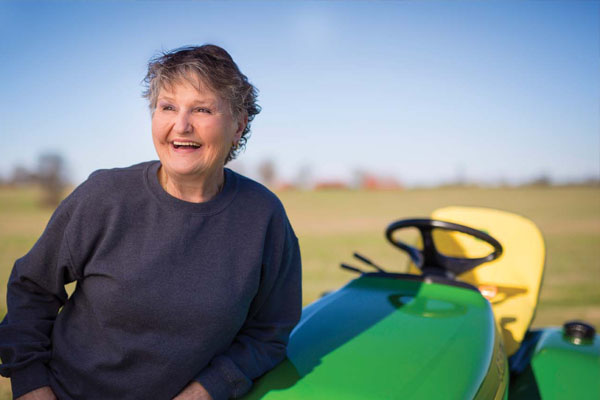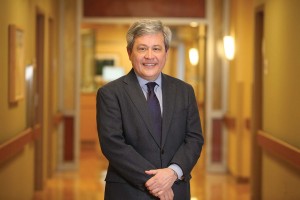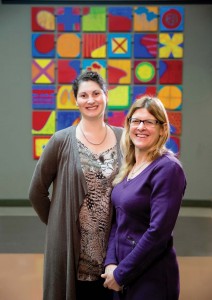Smart Steering
Finding the path to clinical trials
February 1, 2016 | Dagny Stuart

Photo by Daniel Dubois
Judy Tilghman, 66, is a high-energy multitasker who knows how to get things done. Her busy life has included raising two daughters, doing mission work, holding offices in her church, and operating Home Grown Bargains, a consignment store in Hopkinsville, Kentucky. Despite those time demands, this dynamo from Guthrie, Kentucky, was always diligent about getting screening mammograms. In December 2008, a mammogram revealed cancer in her left breast.
Tilghman remembers her husband, Terry’s, response when she called and told him they would have to close the store and retreat from regular life.
“‘Blondie,’ he calls me that even though I’m not blonde, ‘what are you talking about? Get ahold of yourself. This is just another hill to climb. We have had many battles before and we have won and we’re going to fight this one,’” Tilghman said.
Tilghman underwent a mastectomy to remove the breast and received chemotherapy, then a second round of chemotherapy when the cancer reappeared in 2011. Despite the treatment, a PET imaging scan revealed that her cancer had spread to both lungs. Her doctor offered more chemotherapy and told her she had only about a year to live.
“When he put a timeline on my life we knew it was time to get a second opinion,” Tilghman said.
That second opinion led her to Vanderbilt-Ingram Cancer Center (VICC) and Vandana Abramson, M.D., associate professor of Medicine, who enrolled Tilghman in a clinical trial of a promising new drug, called BKM120 or buparlisib, for women with advanced breast cancer.
Abramson explained, “Buparlisib is a PI3K inhibitor that is currently in clinical trials. Through sequencing of Ms. Tilghman’s tumor, we found that her cancer has a mutation in the PIK3CA gene, which encodes for PI3K. The PI3K pathway is important in cancer, and mutations in this pathway are associated with lack of response or resistance to traditional hormone blockers. This clinical trial enabled her to get a drug (buparlisib) that targets a key mutation in her cancer, along with a hormone blocker as her cancer is fed by estrogen.”
Tilghman said the decision to enroll in a clinical research trial was simple.
“I had nothing to lose by trying the medication. If it did not keep mine at bay, maybe they could detect some of the things that happened to help someone else who was in the same condition,” she said.
Tilghman received the first dose Dec. 2, 2011. Five mornings a week, she swallows two pills containing the medication and also takes Femara, a hormone therapy known as an aromatase inhibitor, which reduces the amount of estrogen produced in the body.
The Match Game
This ability to test cancerous tumors, detect the gene mutations that may be driving the tumor’s growth and match the patient to the right therapy is the hallmark of precision medicine. VICC was one of the first major cancer centers in the United States to embrace precision medicine and start routine testing of many tumors to search for gene mutations in cancer.
“We interrogate and profile the genetic makeup of the tumor to find the vulnerabilities that we can exploit with a specific therapy,” explained Carlos L. Arteaga, M.D., director of the Center for Cancer Targeted Therapies and the Breast Cancer Research Program at VICC.

Carlos L. Arteaga, M.D., said cancer therapies may have to be switched
due to gene alterations. Photo by Susan Urmy.
“We now know that cancer, including breast cancer, is not just one disease, it is multiple diseases. And cancer is not static. We can treat a tumor with a therapy based on the mutation or mutations that are present at that time. But if the cancer responds and then reappears and we test the new tumors, the gene mutations may be different and we may need to switch to a different therapy based on the newly detected gene alterations.”
This understanding of the dynamic and shifting drivers of cancer growth and the ability to tailor therapy to those changes has already improved survival rates for some forms of cancer, especially breast cancer. Arteaga said most women whose breast cancer is detected early—at a time when it is still operable—and who receive appropriate therapy can be cured of their disease.
Chemotherapy, which works by destroying fast-growing cells including cancer cells, is often the treatment of choice. For more advanced disease, patients may receive targeted therapy based on the mutations present in the tumor. These new therapies are tested in clinical trials.
Ingrid Mayer, M.D., MSCI, associate professor of Medicine and co-leader and clinical director of the Breast Cancer Research Program, said clinical trials are not just scientific experiments.
“For several of our trials, an investigational new drug is added to standard of care treatments, such as chemotherapy or hormone blocking agents. It is always an opportunity to get an extra weapon against cancer above and beyond what we already know to do,” she said.
Mayer said researchers discovered that some cancers may have more than one mutation driving the tumor’s growth and combination therapies are already in use to try to block multiple molecular pathways in cancerous cells.
“Many of our clinical trials are testing more than one therapy to determine the best combination of therapies or the best order in which to give individual therapies to keep the cancer at bay,” explained Mayer.
Increasing numbers of women are given neoadjuvant therapy, which means they receive chemotherapy or targeted therapy to shrink the tumor prior to surgery, which may allow for breast-conservation surgery.
Working in Harmony
The decision about the order of treatment, whether surgery comes first or after some form of systemic treatment, requires collaboration among all of the experts who treat each patient.
This team science approach is a crucial element in the quest to provide the best outcomes for patients, according to Ingrid Meszoely, M.D., associate professor of Surgical Oncology and medical director of the Vanderbilt Breast Center. Several years ago, VICC consolidated many breast services at Vanderbilt Health One Hundred Oaks in Nashville. Patients can receive screening and diagnostic mammograms at the facility and meet with their radiologist, medical oncologist, surgical oncologist, plastic surgeon and radiation oncologist all in one place.
“I think the team approach is extremely important in cancer therapy. It starts with the surgeon working very closely with the radiologist reviewing the mammogram to understand what is going on anatomically and determining what kind of surgical procedure will be best for that patient. The collaboration between the radiologist and the surgeon is key to the surgical planning,” said Meszoely.
John Huff, M.D., chief of the Section of Breast Imaging and Medical Director of Breast Imaging Services, said he came to VICC because of the commitment to team medicine.
“I had been waiting my entire career to do that. It requires not only a conceptual commitment to function as a team but being able to offer most of the team’s services in one place as we do at the Vanderbilt Breast Center at One Hundred Oaks.”
This integration of specialties enables all of the experts to work collaboratively and create individualized treatment plans for each patient.
“I think it really makes a difference in the care that patients get to have that kind of focus,” said Huff.
In recent years, the Vanderbilt Breast Center upgraded to digital mammography which many consider to be the mainstay for cancer detection. Digital mammography provides effective screening for all women with an average risk for breast cancer. For women at higher risk—those with a 20-25 percent lifetime risk of developing breast cancer—supplemental MRI or ultrasound screening may be appropriate.
“There are some good data to suggest that this population benefits with reduction in mortality from supplemental screening with MRI,” Huff explained.
In addition to regular mammograms, the Vanderbilt Breast Center has added tomosynthesis, also known as 3-D imaging. During the test, the tomosynthesis tube moves over the breast in an arc and the machine takes 20 images along the arc and recreates them as a three-dimensional image that provides more clarity.
“Tomosynthesis is probably the biggest advance in breast imaging we’ve seen since MRI,” said Huff.
Medicare covers the cost of 3-D imaging for some patients but most insurance companies are not providing reimbursement for the test.
Choosing a Path
What radiologists see on these tests helps determine surgical options for patients.
For women with early-stage disease, a lumpectomy may be appropriate. During a lumpectomy, the surgeon removes the tumor and some of the surrounding tissue. Radiation therapy to destroy nearby cancerous cells or second cancers in the same breast is usually recommended for lumpectomy patients.
Meszoely said some women who undergo lumpectomy at VICC are now getting better cosmetic results because of the collaboration between surgical oncologists and plastic surgeons.
In what is known as oncoplasty, plastic surgeons reshape the breast after the cancerous tissue has been removed.

Ingrid A. Mayer, M.D., (left) and Ingrid Meszoely, M.D., are members of the medical team at the Vanderbilt Breast Center. Photo by Joe Howell.
“The plastic surgeon shifts or rotates the remaining good breast tissue to fill in the area which has been removed by the lumpectomy in women with a larger breast size, resulting in a smaller, more lifted breast. They also may take away additional tissue in order to make it proportional to the body,” said Meszoely.
Additional surgery may be performed on the second breast if there are symmetry issues.
Years of research have determined that women with early stage disease who receive lumpectomy followed by radiation have the same survival rates as women who choose to have their breast removed.
Despite this evidence, a growing number of women are choosing to remove not just the breast with the cancerous tumor but the second healthy breast. A 2014 study by Vanderbilt researchers who examined the records of 1.2 million women found rates of bilateral mastectomy (removal of both breasts) for cancer in one breast increased from 1.9 to 11.2 percent from 1998 to 2011.
Meszoely said the decision to remove the healthy breast is often emotional, spurred by the patient’s fear of cancer appearing in the second breast.
But for most women the risk is low.
“The risk of a breast cancer on the other side for the average woman is about .5 to 1 percent per year and that is not a cumulative risk. Their risk of the cancer coming back somewhere else in their body is generally higher than coming back in the other breast,” Meszoely explained.
The Family Tree
While breast cancer is quite common, with about 235,000 new cases each year in the U.S., most women do not know much about their own risk for developing the disease. Those who have relatives with breast cancer often worry about an inherited risk.
It is estimated that about 5 to 10 percent of all cancers have an inherited basis, according to Georgia Wiesner, M.D., Ingram Professor of Cancer Research and director of the Clinical and Translational Hereditary Cancer Program. Wiesner and her team of genetic counselors perform a risk assessment for patients who have concerns about inherited risk factors.
“We take a four -to five-generation pedigree, so we really try to go back as far as we can on that family tree. We are particularly interested in families that have relatives who developed cancer at a younger age than expected or who have developed more than one cancer or have a cluster in types of cancer, such as breast plus ovary or breast plus pancreas cancer,” Wiesner explained.
Patients whose family tree shows these patterns may be offered genetic testing to find out if there is an identifiable gene in the DNA being passed down from one generation to the next. The tests involve a simple blood sample. Using a multi-gene panel, a laboratory tests the blood for gene mutations in the patient’s DNA that are linked to cancer.
In the mid-1990s, scientists identified mutations in the BRCA1 and BRCA2 genes as culprits in the formation of some breast and ovarian cancers. Women and men who harbor this gene mutation are eight to 10 times more likely to develop breast cancer, and the cancer usually occurs at a younger age.
Researchers have also identified CHEK2 which increases breast cancer risk by two or three times, and PALB2 which raises the risk of developing breast and ovary cancer together.
Wiesner said it is important for patients with a suspected inherited cancer risk to receive genetic counseling to determine how much they want to know and whether other family members may be affected by the information.
“Even in people that have strong cancer susceptibility mutations, we know that their chance of developing cancer is not 100 percent. There are people who are mutation carriers who never develop cancer. The flip side is there are people that do develop cancer, so what is the trigger? Is it that the person who never has cancer has beneficial genes in other important areas or is it that it’s not related or is there an environmental trigger that is missing? We don’t know,” said Wiesner.
Judy Tilghman is unaware of any family history of breast cancer, and researchers don’t know the exact cause of her disease.
But the drug therapy used to treat her, which is based on the known features of her tumor, kept the cancer from growing for the past four years.
The results illustrate the promise of precision medicine and clinical research.
“Patients like Ms. Tilghman are why we are so invested in clinical trials,” Abramson said. “She came to us with metastatic disease to the lungs and was planning on treatment with chemotherapy and thought she had one year to live. With a better understanding of what is driving her cancer and by using drugs that target the alterations in her cancer she has had four years on a treatment with minimal side effects. She is a remarkable person and I am thrilled that she has had the ability to continue to live her life and do all of the amazing things that she does.”
Recent tests indicate that Tilghman’s cancer may have reawakened and she likely will be enrolled in a trial of another drug.
